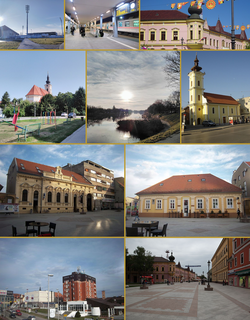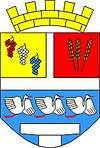Vinkovci
Vinkovci (pronounced [ʋîːŋkoːʋtsi]) is a city in Slavonia, in the Vukovar-Syrmia County in eastern Croatia. In the 2011 census, the total population of the city was 35,312,[2] making it the largest town of the county. Surrounded by many large villages, it is a local transport hub, particularly because of its railways.
Vinkovci | |
|---|---|
| Grad Vinkovci City of Vinkovci | |
 Vinkovci | |
 Seal | |
 Vinkovci Location of Vinkovci in Croatia | |
| Coordinates: 45°17′28″N 018°48′04″E | |
| Country | |
| Region | Slavonia |
| County | |
| Government | |
| • Type | City |
| • Mayor | Ivan Bosančić |
| Area | |
| • City | 94.21 km2 (36.37 sq mi) |
| Elevation | 90 m (300 ft) |
| Population (2011)[2] | |
| • City | 35,312 |
| • Density | 370/km2 (970/sq mi) |
| • Urban | 32,029 |
| Time zone | UTC+1 (CET) |
| • Summer (DST) | UTC+2 (CEST) |
| Postal code | |
| Area code(s) | 32 |
| Vehicle registration | VK |
| Website | vinkovci.hr |
Name
The name Vinkovci is supposed to come from the common Croatian personal name Vinko. It was called Cibalae in antiquity. There are several proposed etymologies for Cibalae. Those who advocate that Illyrian was a satem language generally advocate that it comes from Proto-Indo-European *ghebhel (head), in the sense "hill". Those who advocate the theory that Illyrian was a centum language generally advocate that it comes from Proto-Indo-European words *kjey (house) and *bel (strong), so that it means "strong house".[3]
The name of the city in Croatian is in plural version and therefore it is grammatically correct to refer to it as "Vinkovci are" instead of "Vinkovci is". Hypothetical singular version of the name would be Vinkovac.
In other historically and demographically relevant languages the name of the city is German: Winkowitz, Hungarian: Vinkovce, Serbian Cyrillic: Винковци, Rusyn: Винковцѣ, Latin: Colonia Aurelia Cibalae and Ancient Greek: Κιβέλαι Kibelae.
History

The area around Vinkovci has been continually inhabited since the Neolithic period. It was made a municipium (the Roman name for town or city) under Hadrian and gained the status of Colonia Aurelia Cibalae during the reign of emperor Caracalla.[4][5] It was the birthplace of Roman emperors Valentinian I and Valens. The Roman thermal bath is still preserved underground, along with several other Roman buildings located near the center of today's Vinkovci.[6] The 4th century Battle of Cibalae, between the armies of Constantine the Great and Licinius, was fought nearby.
From 1526 to 1687 it was part of the Ottoman Empire, administratively located in Sirem sanjak (whose seat was in Dimitrofça) within the Budin Eyalet. It was captured by the Habsburg Empire in 1687, which was later confirmed by the Treaty of Karlowitz in 1699. Until 1918, Vinkovci (named Winkowcze before 1850)[7] was part of the Austrian monarchy (Kingdom of Croatia-Slavonia after the compromise of 1867), in the Slavonian Military Frontier, under the administration of the Brooder Grenz-Infanterie-Regiment Nr. VII until 1881.
In the late 19th and early 20th century, Vinkovci was a district capital in the Syrmia County of the Kingdom of Croatia-Slavonia. From 1941 to 1945, Vinkovci was part of the Independent State of Croatia. From 17 April 1944 the city was heavily bombed by the Allies due to its important position in transportation.[8] Vinkovci Synagogue was among the largest and the most prestigious synagogues in Croatia. It was destroyed by the Croatian government in 1941–42.
The city and its surroundings were gravely impacted by the 1991–95 Croatian War of Independence. The city was close to the front lines between the forces of Croatia and the rebel Serbs, but it managed to avoid the fate of nearby Vukovar, which was besieged in the infamous Battle of Vukovar. The eastern sections of the town were substantially damaged by shelling, and the nearby village of Cerić was almost completely destroyed. The most significant destruction in the town center were the town library, which burned down to the ground, the town court, the Catholic and Orthodox churches (the Church of Saints Eusebius and Polion and the Church of Pentecost, respectively), both of its hospitals, the town theatre, two cinemas, and a host of businesses and factories. The Church of Pentecost was dynamited by local Croatian forces as retaliation after rebel Serbs forces severely damaged the local Catholic rectory.[9] In December 1995–96, the Vinkovci rail station served as a rail offloading base for the United States Army's 1st Armored Division en route to Županja to cross the Sava River into Bosnia during Operation Joint Endeavor.
.jpg)
The Croatian Army has stationed the headquarters of its Armored-Mechanized Guard Brigade at Vinkovci barracks. The current brigade was formed in 2007 and it incorporated two former guards brigades (3rd and 5th) as well as several other units formed in the 1990s during the war of independence.
Geography
Vinkovci is located in the eastern part of the Slavonia region, 19 km (12 mi) southwest of Vukovar, 24 km (15 mi) north of Županja and 43 km (27 mi) south of Osijek. The city lies in a flatland on the Bosut river, at an elevation of approx. 90 metres (300 ft), and has a mild continental climate. Vinkovci is also part of the smaller subregion of Syrmia.
It is connected to all main railroad routes in the region, while state roads D46 and D55 connect it to motorways; river Bosut is not a waterway. Nearby villages and adjacent municipalities include Ivankovo, Jarmina, Markušica, Nuštar, Privlaka and Stari Jankovci.
Demographics
| Year | Pop. | ±% |
|---|---|---|
| 1857 | 4,493 | — |
| 1869 | 5,773 | +28.5% |
| 1880 | 7,315 | +26.7% |
| 1890 | 8,123 | +11.0% |
| 1900 | 9,832 | +21.0% |
| 1910 | 11,670 | +18.7% |
| 1921 | 12,640 | +8.3% |
| 1931 | 16,038 | +26.9% |
| 1948 | 18,633 | +16.2% |
| 1953 | 20,834 | +11.8% |
| 1961 | 25,313 | +21.5% |
| 1971 | 31,605 | +24.9% |
| 1981 | 35,944 | +13.7% |
| 1991 | 38,580 | +7.3% |
| 2001 | 35,912 | −6.9% |
| 2011 | 35,312 | −1.7% |
| Source: Naselja i stanovništvo Republike Hrvatske 1857–2001, DZS, Zagreb, 2005 & Popis stanovništva 2011 | ||
The city administrative area includes the following settlements:[2]
- Mirkovci, population 3,283
- Vinkovci, population 32,029
In 2011, it was the 17th largest city in Croatia.
By ethnic group, as of census 2011, the population of Vinkovci is:[10]
- Croats, 92.35%
- Serbs, 4.87%
- Hungarians, 0.46%
- Others, 2.32%
Economy and transportation
Its economy is primarily based on trade, transport and food and metal processing. Industries include foodstuff, building material, wood and timber, metal-processing, leather and textile. Due to the surrounding farmland, also notable are farming and livestock breeding, and the town hosts a Crop Improvement Centre.
Vinkovci railway station is the main railway junction of eastern Croatia, of railroads leading from Bosnia and Herzegovina toward Hungary and from the capital Zagreb toward Belgrade. The large railway junction, after Zagreb the second largest in Croatia, underlies the importance of transit in Vinkovci. Vinkovci is also the meeting point of the Posavina and Podravina roads and the intersection of the main road D55 Županja–Vinkovci–Vukovar and several regional roads.
Vinkovci, though it is spelled Vincovci in the book, and its rail station are featured in Agatha Christie's Murder on the Orient Express as the place near which the Orient Express breaks down.
Culture
The town features extremely rich cultural and historical heritage, the most interesting attraction being the pre-Romanesque church on Meraja from 1100, with the coats of arms of the kings Koloman and Ladislas, as one of the most important medieval cultural monuments in Croatia. The building has recently had the ancient timber beams removed and a new, modern, brick upper section and roof added.
The most famous annual event, one of the biggest in Slavonia, is the folk music festival "Vinkovci Autumns" (Vinkovačke Jeseni), which includes the folklore show and the presentation of folk customs of Slavonia. It is characterized by a number of original folk music performances, beautiful traditional costumes, a beauty contest, competitions of the manufacturers of kulen (smoked paprika-flavoured sausage), plum brandy and other traditional foodstuffs, and especially by the magnificent closing parade.
Vinkovci's music school Josip Runjanin is named after the composer of the Croatian national anthem Lijepa naša domovino. The Vinkovci gymnasium is named after Matija Antun Reljković, a Slavonian writer who lived in the city in the 18th century.
Monuments and sights
Notable natives and residents
- Goran Bare, rock singer (Majke, Hali Gali Halid)
- Vanja Drach, actor
- Mirko Filipović, Kickboxer and Mixed Martial-Arts fighter
- Satan Panonski, Yugoslav and Croatian musician and freak performer
- Mavro Frankfurter, last Vinkovci Rabbi
- Carl Heitzmann, pathologist and dermatologist
- Lavoslav Kadelburg, lawyer, judge, polyglot and activist
- Branko Karačić, footballer/manager
- Mario Kasun, basketballer
- Josip Kozarac, writer
- Ivan Kozarac, writer
- Dubravko Mataković, cartoonist
- Dina Merhav, Israeli sculptor
- Eugen Miskolczy, physician
- Otto Miskolczy, entrepreneur and World War II Partisan
- Josip Runjanin, composer of Croatian anthem
- Stjepan Šejić, comic-book author
- Rade Šerbedžija, actor
- Erich Šlomović, art collector
- Josip Šokčević, Croatian viceroy
- Theodoric the Great, ostrogothic ruler and king of Italy
- Valens, Roman Emperor
- Valentinian, Roman Emperor
- Ivan Bošnjak footballer
International relations
Twin towns — sister cities
Vinkovci is twinned with:
Sport
A local football club still carries the Latin name for Vinkovci, Cibalia.
See also
References
Bibliography
- Cresswell, Peterjon; Atkins, Ismay; Dunn, Lily (10 July 2006). Time Out Croatia (First ed.). London, Berkeley & Toronto: Time Out Group Ltd & Ebury Publishing, Random House Ltd. 20 Vauxhall Bridge Road, London SV1V 2SA. ISBN 978-1-904978-70-1. Retrieved 10 March 2010.
Notes
- "Vinkovci" (in Croatian). Vukovar-Srijem County. 2009. Retrieved 2010-08-12.
- "Population by Age and Sex, by Settlements, 2011 Census: Vinkovci". Census of Population, Households and Dwellings 2011. Zagreb: Croatian Bureau of Statistics. December 2012.
- "Croatian toponyms". Linguist Forum. Retrieved 5 April 2018.
- Report on the Situation of Urban Archaeology in Europe. Council of Europe. 1999. p. 54. ISBN 978-9287136718. Retrieved 2 November 2017.
- "Povijest grada" (in Croatian). City of Vinkovci. Retrieved 25 September 2015.
- Ivana Iskra Janošić (2001). Urbanization of Cibalae and development of centers for pottery production. Zagreb-Vinkovci. pp. 31–33, 147–150.
- Edwin Mueller (1961). Handbook of Austria and Lombardy-Venetia Cancellations on the Postage Stamp Issues 1850–1864.
- Marica Karakaš. "Saveznička bombardiranja Srijema u Drugome svjetskom ratu" (PDF) (in Croatian, English, and German). Zagreb, Croatia: Political Science Research Centre. Archived from the original (PDF) on 2011-05-22. Retrieved 2010-08-12.
- "Zlo u ratu, dobrota u miru". Novosti (in Serbian) (585). 2012-03-05. Retrieved 2012-04-05.
- "Population by Ethnicity, by Towns/Municipalities, 2011 Census: County of Vukovar-Sirmium". Census of Population, Households and Dwellings 2011. Zagreb: Croatian Bureau of Statistics. December 2012.
-Crkva_Silaska_Sv._duha.jpg)


